Technology
Nvidia CEO touts India’s progress with sovereign AI and over 100K AI developers trained
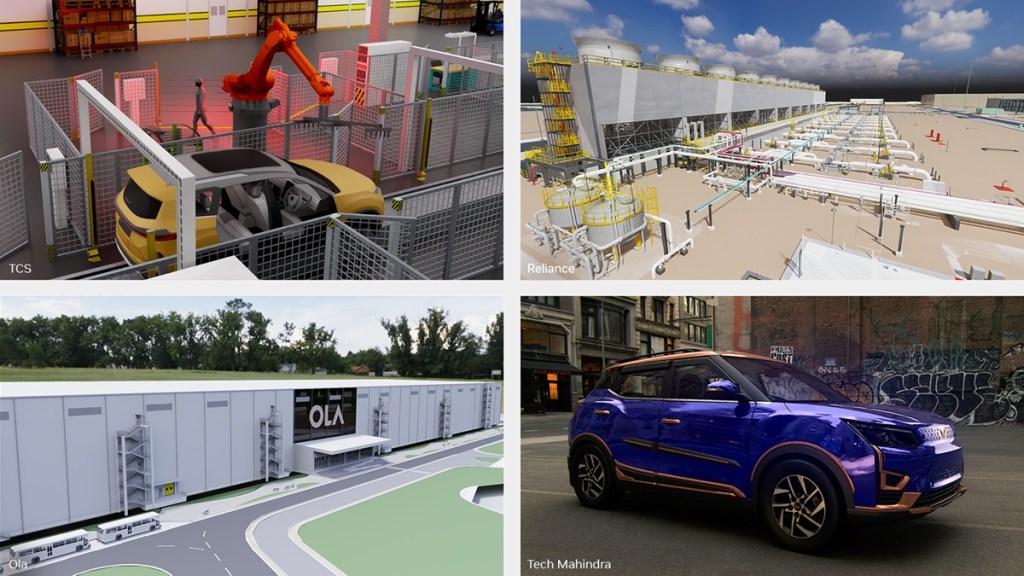
Join our daily and weekly newsletters for the latest updates and exclusive content on industry-leading AI coverage. Learn More
Nvidia CEO Jensen Huang noted India’s progress in its AI journey in a conversation at the Nvidia AI Summit in India. India now has more than 2,000 Nvidia Inception AI companies and more than 100,000 developers trained in AI.
That compares to a global developer count of 650,000 people trained in Nvidia AI technologies, and India’s strategic move into AI is a good example of what Huang calls “sovereign AI,” where countries choose to create their own AI infrastructure to maintain control of their own data.
Nvidia said that India is becoming a key producer of AI for virtually every industry — powered by thousands of startups that are serving the country’s multilingual, multicultural population and scaling
out to global users.
The country is one of the top six global economies leading generative AI adoption and has seen rapid growth in its startup and investor ecosystem, rocketing to more than 100,000 startups this year from under 500 in 2016.
More than 2,000 of India’s AI startups are part of Nvidia Inception, a free program for startups designed to accelerate innovation and growth through technical training and tools, go-to-market support and opportunities to connect with venture capitalists through the Inception VC Alliance.
At the NVIDIA AI Summit, taking place in Mumbai through Oct. 25, around 50 India-based startups are sharing AI innovations delivering impact in fields such as customer service, sports media, healthcare and robotics.
Conversational AI for Indian Railway customers

Bengaluru-based startup CoRover.ai already has over a billion users of its LLM-based conversational AI platform, which includes text, audio and video-based agents.
“The support of NVIDIA Inception is helping us advance our work to automate conversational AI use cases with domain-specific large language models,” said Ankush Sabharwal, CEO of CoRover, in a statement. “NVIDIA AI technology enables us to deliver enterprise-grade virtual assistants that support 1.3 billion users in over 100 languages.”
CoRover’s AI platform powers chatbots and customer service applications for major private and public sector customers, such as the Indian Railway Catering and Tourism Corporation, the official provider of online tickets, drinking water and food for India’s railways stations and trains.
Dubbed AskDISHA, after the Sanskrit word for direction, the IRCTC’s multimodal chatbot handles more than 150,000 user queries daily, and has facilitated over 10 billion interactions for more than 175 million passengers to date. It assists customers with tasks such as booking or canceling train tickets, changing boarding stations, requesting refunds, and checking the status of their booking in languages including English, Hindi, Gujarati and Hinglish — a mix of Hindi and English.
The deployment of AskDISHA has resulted in a 70% improvement in IRCTC’s customer satisfaction rate and a 70% reduction in queries through other channels like social media, phone calls and emails.
CoRover’s modular AI tools were developed using Nvidia NeMo, an end-to-end, cloud-native framework and suite of microservices for developing generative AI. They run on Nvidia GPUs in the cloud, enabling CoRover to automatically scale up compute resources during peak usage — such as the moment train tickets are released.
Nvidia also noted that VideoVerse, founded in Mumbai, has built a family of AI models using Nvidia technology to support AI-assisted content creation in the sports media industry — enabling global customers including the Indian Premier League for cricket, the Vietnam Basketball Association and the Mountain West Conference for American college football to generate game highlights up to 15 times faster and boost viewership. It uses Magnifi, with tech like vision analysis to detect players and key moments for short form video.
Nvidia also highlighted Mumbai-based startup Fluid AI, which offers generative AI chatbots, voice calling bots and a range of application programming interfaces to boost enterprise efficiency. Its AI tools let workers perform tasks like creating slide decks in under 15 seconds.
Karya, based in Bengaluru, is a smartphone-based digital work platform that enables members of low-income and marginalized communities across India to earn supplemental income by completing language-based tasks that support the development of multilingual AI models. Nearly 100,000 Karya workers are recording voice samples, transcribing audio or checking the accuracy of AI-generated sentences in their native languages, earning nearly 20 times India’s minimum wage for their work. Karya also provides royalties to all contributors each time its datasets are sold to AI developers.
Karya is employing over 30,000 low-income women participants across six language groups in India to help create the dataset, which will support the creation of diverse AI applications across agriculture, healthcare and banking.
Serving over a billion local language speakers with LLMs

Namaste, vanakkam, sat sri akaal — these are just three forms of greeting in India, a country with 22 constitutionally recognized languages and over 1,500 more recorded by the country’s census. Around 10% of its residents speak English, the internet’s most common language.
As India, the world’s most populous country, forges ahead with rapid digitalization efforts, its government and local startups are developing multilingual AI models that enable more Indians to interact with technology in their primary language. It’s a case study in sovereign AI — the development of domestic AI infrastructure that is built on local datasets and reflects a region’s specific dialects, cultures and practices.
These public and private sector projects are building language models for Indic languages and English that can power customer service AI agents for businesses, rapidly translate content to broaden access to information, and enable government services to more easily reach a diverse population of over 1.4 billion individuals.
To support initiatives like these, Nvidia has released a small language model for Hindi, India’s most prevalent language with over half a billion speakers. Now available as an Nvidia NIM microservice, the model, dubbed Nemotron-4-Mini-Hindi-4B, can be easily deployed on any Nvidia GPU-accelerated system for optimized performance.
Tech Mahindra, an Indian IT services and consulting company, is the first to use the Nemotron Hindi NIM microservice to develop an AI model called Indus 2.0, which is focused on Hindi and dozens of its dialects.
Indus 2.0 harnesses Tech Mahindra’s high-quality fine-tuning data to further boost model accuracy, unlocking opportunities for clients in banking, education, healthcare and other industries to deliver localized services.
The Nemotron Hindi model has 4 billion parameters and is derived from Nemotron-4 15B, a 15-billion parameter multilingual language model developed by Nvidia. The model was pruned, distilled and trained with a combination of real-world Hindi data, synthetic Hindi data and an equal amount of English data using Nvidia NeMo, an end-to-end, cloud-native framework and suite of microservices for developing generative AI.
The dataset was created with Nvidia NeMo Curator, which improves generative AI model accuracy by processing high-quality multimodal data at scale for training and customization. NeMo Curator uses Nvidia RAPIDS libraries to accelerate data processing pipelines on multi-node GPU systems, lowering processing time and total cost of ownership.
It also provides pre-built pipelines and building blocks for synthetic data generation, data filtering, classification and deduplication to process high-quality data.
After fine-tuning with NeMo, the final model leads on multiple accuracy benchmarks for AI models with up to 8 billion parameters. Packaged as a NIM microservice, it can be easily harnessed to support use cases across industries such as education, retail and healthcare.
It’s available as part of the Nvidia AI Enterprise software platform, which gives businesses access to additional resources, including technical support and enterprise-grade security, to streamline AI development for production environments. A number of Indian companies are using the services.
India’s AI factories can transform economy

India’s leading cloud infrastructure providers and server manufacturers are ramping up accelerated data center capacity in what Nvidia calls AI factories. By year’s end, they’ll have boosted Nvidia GPU
deployment in the country by nearly 10 times compared to 18 months ago.
Tens of thousands of Nvidia Hopper GPUs will be added to build AI factories — large-scale data centers for producing AI — that support India’s large businesses, startups and research centers running AI workloads in the cloud and on premises. This will cumulatively provide nearly 180 exaflops of compute to power innovation in healthcare, financial services and digital content creation.
Announced today at the Nvidia AI Summit, this buildout of accelerated computing technology is led by data center provider Yotta Data Services, global digital ecosystem enabler Tata Communications, cloud service provider E2E Networks and original equipment manufacturer Netweb.
Their systems will enable developers to harness domestic data center resources powerful enough to fuel a new wave of large language models, complex scientific visualizations and industrial digital twins that could propel India to the forefront of AI-accelerated innovation.
Yotta Data Services is providing Indian businesses, government departments and researchers access to managed cloud services through its Shakti Cloud platform to boost generative AI adoption and AI education.
Powered by thousands of Nvidia Hopper GPUs, these computing resources are complemented by Nvidia AI Enterprise, an end-to-end, cloud-native software platform that accelerates data science pipelines and streamlines development and deployment of production-grade copilots and other generative AI applications.
With Nvidia AI Enterprise, Yotta customers can access Nvidia NIM, a collection of microservices for optimized AI inference, and Nvidia NIM Agent Blueprints, a set of customizable reference architectures for generative AI applications. This will allow them to rapidly adopt optimized, state-of-the-art AI for applications including biomolecular generation, virtual avatar creation and language generation.
“The future of AI is about speed, flexibility and scalability, which is why Yotta’s Shakti Cloud platform is designed to eliminate the common barriers that organizations across industries face in AI adoption,” said Sunil Gupta, CEO of Yotta, in a statement. “Shakti Cloud brings together high-performance GPUs, optimized storage and a services layer that simplifies AI development from model training to deployment, so organizations can quickly scale their AI efforts, streamline operations and push the boundaries of what AI can accomplish.”
Source link
Technology
Australian cricketer Steve Waugh at Bengaluru Space Expo- The Week
Former Australian cricketer Steve Waugh says that he is learning a lot about space technology and is very excited about it. He was a surprise at the Bengaluru Space Expo (BSX) 2024 that began today. “I am surprised myself to be at the space expo. Space is exciting and new for me and I am learning a lot about space as I go along. I am very happy to be involved in this joint venture between Austraila and India. I have been coming to India for the last forty years with charity, with cricket, with business and this is another opportunity to collaborate with India. I am excited to be involved in it and Australia and India can do great things together in space technology,” said Waugh who is also the brand ambassador of Space Machines Company an Australian India in space servicing firm.
The Space Machines Company has forged strategic partnerships with two Indian companies Ananth Technologies and Digantara. These partnerships are expected to play a significant role in the upcoming Space MAITRI (Mission for Australia-India’Technology, Research and Innovation) mission and the launch of Space Machines Company’s second Optimus satellite. Scheduled for 2026, the satellite will be deployed abroad NewSpace India Limited (NSIL) Small Satellite Launch Vehicle (SSLV).
It will be the largest Australian-made spacecraft in orbit. The Space Machines Company’s second Optimus spacecraft, a 450 kg Orbital Servicing Vehicle will be launched on NSIL’s Small Satellite Launch Vehicle and is part of the first dedicated launch agreement between Australia and India.
The mission will focus on debris management and sustainability and will significantly advance Australia’s domestic space industry, by combining Australian spacecraft capabilities with India’s launch expertise.
“We will work closely with Ananth Technologies and Digantara throughout the space MAITRI project lifecycle, leveraging each company’s advanced engineering, logisitc, and situation space awareness capabilities to fulfil the joint Australian-Indian mission of building a more sustainable space future,” said Rajat Kulshrestha, CEO and Co-founder of Space Machines Company.
Under the partnership, Ananth Technologies will provide Assembly Integration and Testing (AIT) and comprehensive engineering and logistics support throughout the Space MAITRI program. This will include the safe transportation and handling of all spacecraft components in India, extensive testing and launch site spacecraft fueling. This collaboration with Ananth Technologies between the two companies will ensure that Space Machines Company’s second Optimus spacecraft is successfully integrated into the SSLV and ready for launch.
On the other hand, the collaboration with Digantara will enable the Optimus spacecraft to track and engage short range resident space objects a vital capability when executing close approach maneuvers during in orbit operations.
Interestingly the Australian government has invested $ 8.5 million in the Space MAITRI mission in April 2024 through the Australian Space Agency’s $18 million International Space Investment India Projects program. “This mission and the collaborations that underpin it emphasise the role that space can play in enhancing cooperation in the Indo-Pacific region for mutual benefit. This mission leverages our nation’s respective capabilities and advantages to make space activities more sustainable-something the global space community is focussed on to protect and maintain the assets in orbit that are central to a functioning modern society,” remarked Enrico Palermo, head of the Australian Space Agency.
Space Machines Company is an Australian company that delivers on orbit servicing and protection of critical space infrastructure through its Orbital Servicing Network. This company supports mobility, inspection, deorbiting, repair, life extension and protection capbaility to satellite customers when and where they need it.
Technology
The Call review: Musical AI harmonises with your voice in a transcendent new exhibition
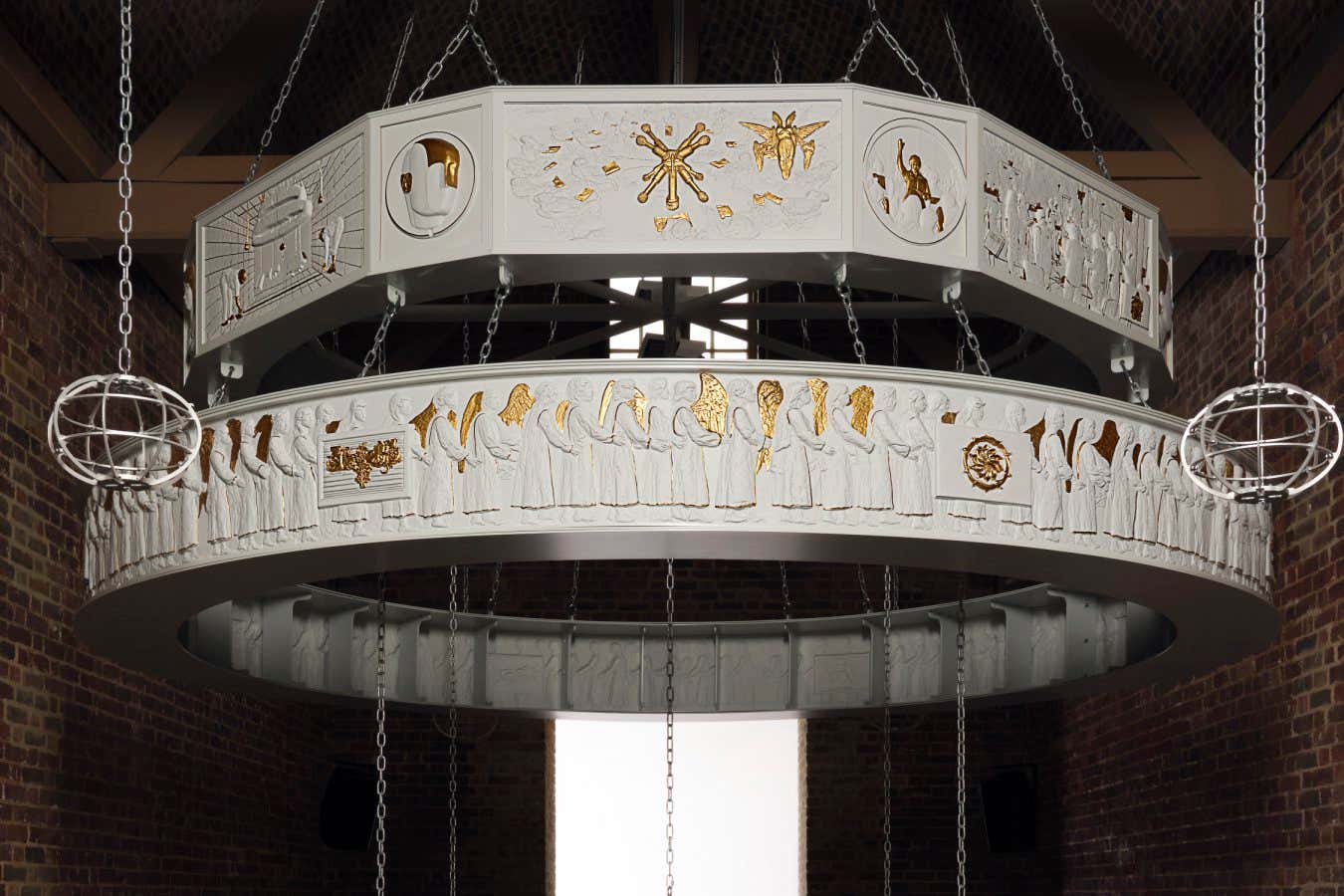

A chandelier evokes the rig of microphones used to capture the recordings
Leon Chew, The Call, Holly Herndon and Mat Dryhurst with sub, Serpentine, 2024
The Call
Holly Herndon and Mat Dryhurst
Serpentine North, London Closes 2 February 2025
Step into London’s Serpentine North gallery and the first thing you see is an organ. But it is far from a conventional instrument with gleaming flues and reeds. This organ is made up of fans used to cool graphics processing units. Each fan whirs at a pitch that depends on its oscillation, and the sounds combine in an otherworldly hymn…
Science & Environment
What happened when a rock as big as London hit Earth?
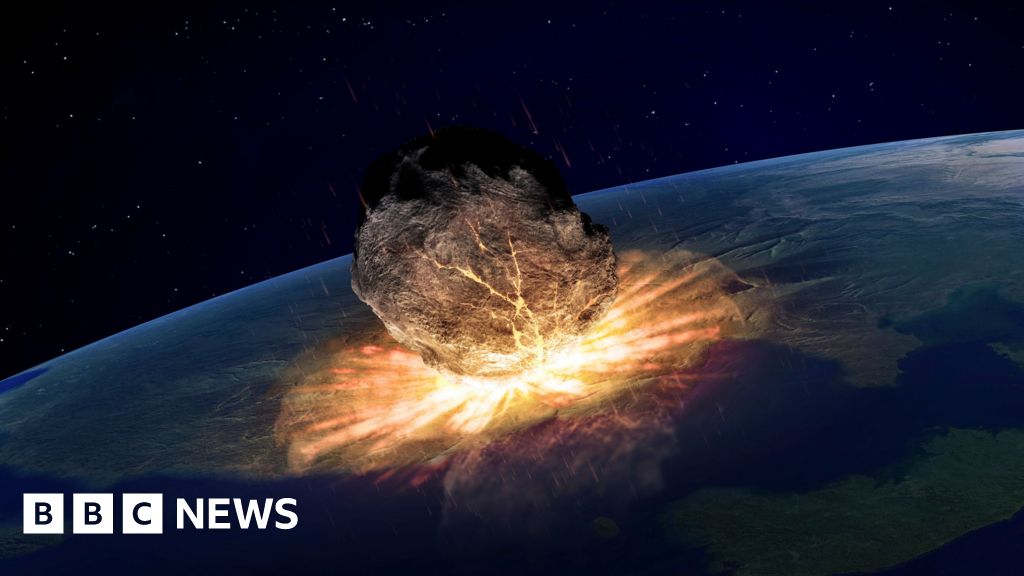
 Getty Images
Getty ImagesA huge meteorite first discovered in 2014 caused a tsunami bigger than any in known human history and boiled the oceans, scientists have discovered.
The space rock, which was 200 times the size of the one that wiped out the dinosaurs, smashed into Earth when our planet was in its infancy three billion years ago.
Carrying sledge hammers, scientists hiked to the impact site in South Africa to chisel off chunks of rock to understand the crash.
The team also found evidence that massive asteroid impacts did not bring only destruction to Earth – they helped early life thrive.
“We know that after Earth first formed there was still a lot of debris flying around space that would be smashing into Earth,” says Prof Nadja Drabon from Harvard university, lead author of the new research.
“But now we have found that life was really resilient in the wake of some of these giant impacts, and that it actually bloomed and thrived,” she says.
The meteorite S2 was much larger than the space rock we are most familiar with. The one that led to the dinosaurs’ extinction 66 million years ago was about 10km wide, or almost the height of Mount Everest.
But S2 was 40-60km wide and its mass was 50-200 times greater.
It struck when Earth was still in its early years and looked very different. It was a water world with just a few continents sticking out of the sea. Life was very simple – microorganisms composed of single cells.
 Nadja Drabon
Nadja DrabonThe impact site in Eastern Barberton Greenbelt is one of the oldest places on Earth with remnants of a meteorite crash.
Prof Drabon travelled there three times with her colleagues, driving as far as possible into the remote mountains before hiking the rest of the way with backpacks.
Rangers accompanied them with machine guns to protect them against wild animals like elephants or rhinos, or even poachers in the national park.
They were looking for spherule particles, or tiny fragments of rock, left behind by impact. Using sledge hammers, they collected hundreds of kilograms of rock and took them back to labs for analysis.
Prof Drabon stowed the most precious pieces in her luggage.
“I usually get stopped by security, but I give them a big spiel about how exciting the science is and then they get really bored and let me through,” she says.
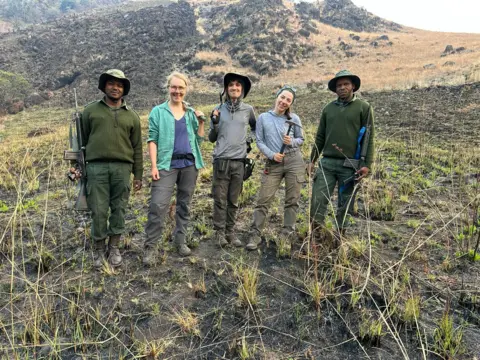 Nadja Drabon
Nadja DrabonThe team have now re-constructed just what the S2 meteorite did when it violently careened into Earth. It gouged out a 500km crater and pulverised rocks that ejected at incredibly fast speeds to form a cloud that circled around the globe.
“Imagine a rain cloud, but instead of water droplets coming down, it’s like molten rock droplets raining out of the sky,” says Prof Drabon.
A huge tsunami would have swept across the globe, ripped up the sea floor, and flooded coastlines.
The 2004 Indian Ocean tsunami would have paled in comparison, suggests Prof Drabon.
All that energy would have generated massive amounts of heat that boiled the oceans causing up to tens of metres of water to evaporate. It would also have increased air temperatures by up to 100C.
The skies would have turned black, choked with dust and particles. Without sunlight penetrating the darkness, simple life on land or in shallow water that relied on photosynthesis would have been wiped out.
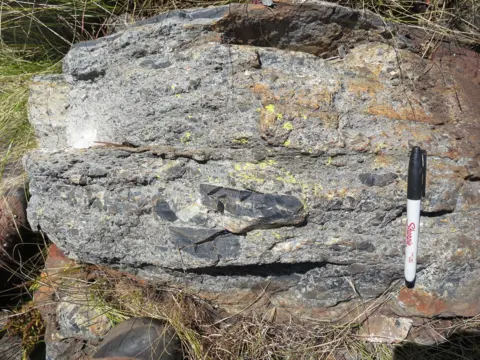 Nadja Drabon
Nadja DrabonThese impacts are similar to what geologists have found about other big meteorite impacts and what was suspected for S2.
But what Prof Drabon and her team found next was surprising. The rock evidence showed that the violent disturbances churned up nutrients like phosphorus and iron that fed simple organisms.
“Life was not only resilient, but actually bounced back really quickly and thrived,” she says.
“It’s like when you brush your teeth in the morning. It kills 99.9% of bacteria, but by the evening they’re all back, right?” she says.
The new findings suggest that the big impacts were like a giant fertiliser, sending essential ingredients for life like phosphorus around the globe.
The tsunami sweeping the planet would also have brought iron-rich water from the depths to the surface, giving early microbes extra energy.
The findings add to a growing view among scientists that early life was actually helped by the violent succession of rocks striking Earth in its early years, Prof Drabon says.
“It seems that life after the impact actually encountered really favourable conditions that allowed it to bloom,” she explains.
The findings are published in the scientific journal PNAS.
Technology
NYT Mini Crossword today: puzzle answers for Thursday, October 24


The New York Times has introduced the next title coming to its Games catalog following Wordle’s continued success — and it’s all about math. Digits has players adding, subtracting, multiplying, and dividing numbers. You can play its beta for free online right now.
In Digits, players are presented with a target number that they need to match. Players are given six numbers and have the ability to add, subtract, multiply, or divide them to get as close to the target as they can. Not every number needs to be used, though, so this game should put your math skills to the test as you combine numbers and try to make the right equations to get as close to the target number as possible.
Players will get a five-star rating if they match the target number exactly, a three-star rating if they get within 10 of the target, and a one-star rating if they can get within 25 of the target number. Currently, players are also able to access five different puzzles with increasingly larger numbers as well. I solved today’s puzzle and found it to be an enjoyable number-based game that should appeal to inquisitive minds that like puzzle games such as Threes or other The New York Times titles like Wordle and Spelling Bee.
In an article unveiling Digits and detailing The New York Time Games team’s process to game development, The Times says the team will use this free beta to fix bugs and assess if it’s worth moving into a more active development phase “where the game is coded and the designs are finalized.” So play Digits while you can, as The New York Times may move on from the project if it doesn’t get the response it is hoping for.
Digits’ beta is available to play for free now on The New York Times Games’ website
Science & Environment
Polar bears face higher risk of disease in a warming Arctic

 USGS
USGSAs the Arctic warms, polar bears face a growing risk of contracting viruses, bacteria and parasites that they were less likely to encounter just 30 years ago, research has revealed.
In a study that has provided clues about how polar bear disease could be linked to ice loss, scientists examined blood samples from bears in the Chukchi Sea – between Alaska and Russia.
They analysed samples that had been gathered between 1987 and 1994, then collected and studied samples three decades later – between 2008 and 2017.
The researchers found that significantly more of the recent blood samples contained chemical signals that bears had been infected with one of five viruses, bacteria or parasites.
 USGS
USGSIt is difficult to know, from blood samples, how the bears’ physical health was affected, but wildlife biologist Dr Karyn Rode from the US Geological Survey said it showed that something was changing throughout the whole Arctic ecosystem.
The researchers tested for six different pathogens in total – viruses, bacteria or parasites that are primarily associated with land-based animals but have been recorded before in marine animals, including species that polar bears hunt.
The study covered three decades, Dr Rode said, “when there had been a substantial loss of sea ice and there’s been increased land use in [this population of polar bears]”.
“So we wanted to know if exposure had changed – particularly for some of these pathogens that we think are primarily land-oriented.”
The five pathogens, as disease-causing agents are collectively called, that have become more common in polar bears, are two parasites that cause toxoplasmosis and neosporosis, two types of bacteria that cause rabbit fever and brucellosis, and the virus that causes canine distemper.
“Bears in general are pretty robust to disease,” explained Dr Rode. “It’s not typically been known to affect bear population, but I think what it just highlights is that things [in the Arctic] are changing.”
Key polar bear facts
- There are about 26,000 polar bears left in the world, with the majority in Canada. Populations are also found in the US, Russia, Greenland and Norway
- Polar bears are listed as vulnerable to extinction by the International Union for Conservation of Nature, with climate change a key factor in their decline
- Adult males can grow to be around 3m long and can weigh close to 600kg
- Polar bears can eat up to 45kg of blubber in one sitting
- These bears have a powerful sense of smell and can sniff out prey from up to 16km away
- They are strong swimmers and have been spotted up to 100km offshore. They can swim at speeds of around 10km per hour, due in part to their paws being slightly webbed
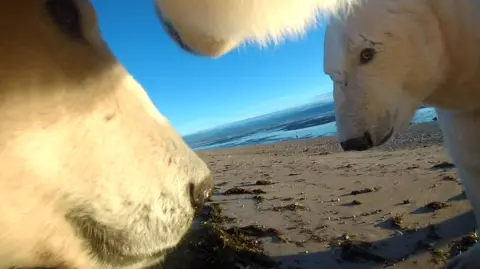 USGS
USGSIn the US, polar bears are classified as a threatened species; scientists say the biggest threat to their future is the continuing loss of sea ice habitat, which they depend on as a platform from which to pounce on their marine prey.
Previous research using collar cameras on bears has shown that, as they spend more of the year on land – when there is no available sea ice to hunt from – the bears are unable to find enough calories.
Dr Rode explained that polar bears are top predators: “Our study suggested that they’re getting their exposure to some pathogens primarily through their prey species.
“So what we saw as changes in pathogen exposure for polar bears is indicative of changes that other species are also experiencing.”
The findings are published in the scientific journal PLOS One.

Technology
Mistral AI & Qualcomm partner will boost AI on Snapdragon devices
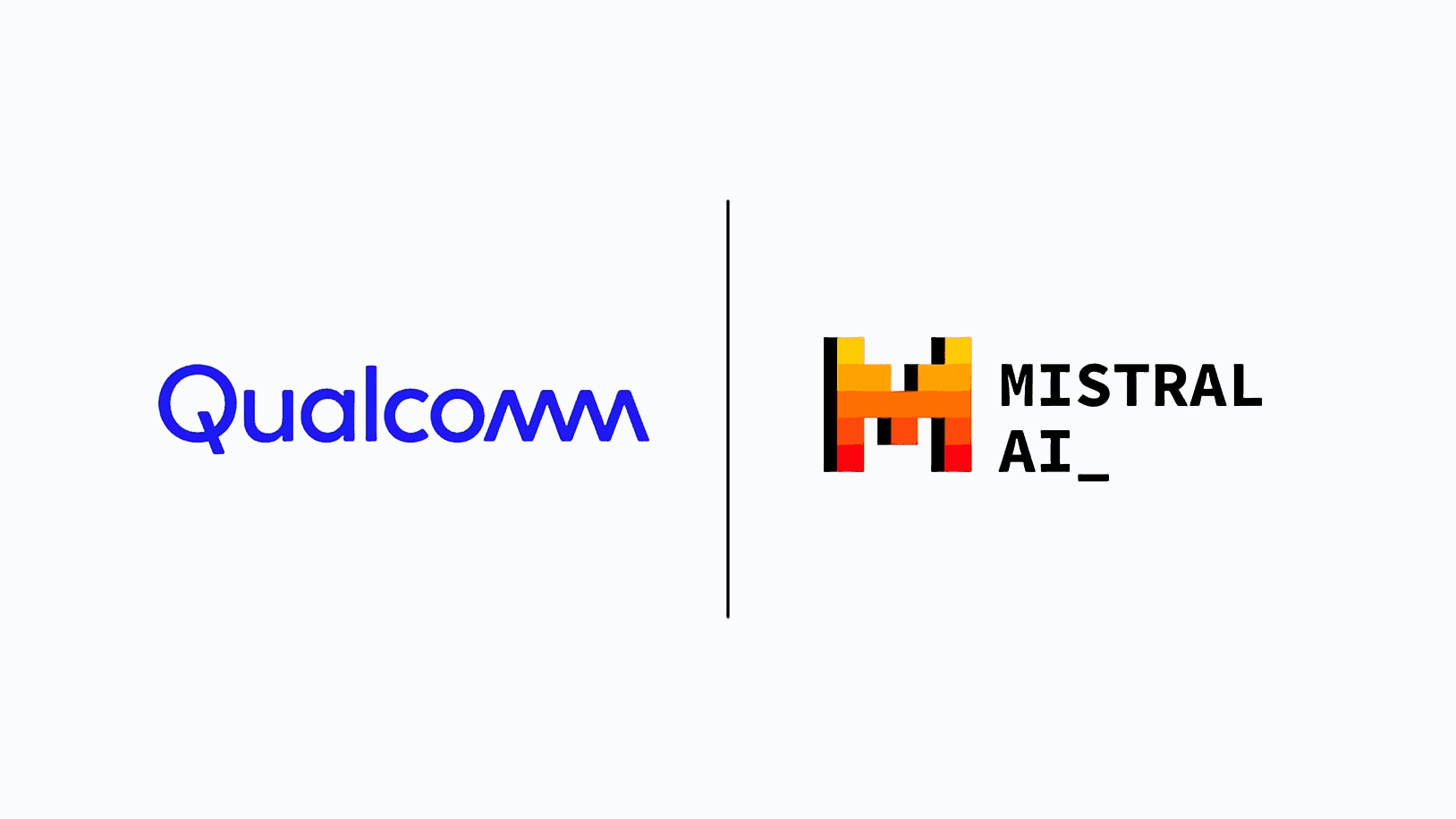
Qualcomm is one of the companies that has been driving the development of artificial intelligence in the tech industry. The company offers powerful AI processing capabilities for both laptops and mobile devices with its Snapdragon chips. There is also the Qualcomm AI Hub, which makes it easier for developers to access multiple AI models from a single site. Now, Qualcomm has announced Mistral AI as a new partner in the integration of more AI models on Snapdragon hardware.
The market for AI models is witnessing an increasing number of alternatives. New companies have emerged to compete with their own models adapted to different needs. For example, Meta recently presented an AI model capable of autonomously evaluating and training other AI models. There is also Personal AI that enables offline assistant experiences with a business focus on Snapdragon-powered laptops.
Mistral AI is the latest Qualcomm partner to bring AI experiences to Snapdragon-powered devices
The Mistral AI models bear similarities to Personal AI, but they cater to a wider audience and possess sufficient versatility to seamlessly integrate with devices such as PCs, smartphones, and vehicles.
Qualcomm has announced the optimization of the Mistral AI models for its multiple hardware platforms. These include the Snapdragon 8 Elite, Snapdragon Cockpit Elite, Snapdragon Ride Elite, and Snapdragon X Elite. For reference, the Mistral AI models share a similar goal to that of the Gemini Nano. That is, the Mistral AI models are designed to be low-power models, making them ideal for enabling on-device AI experiences on mobile devices. However, Mistral AI asserts that its models are also compatible with cars.
“Mistral AI’s Ministral 3B and Ministral 8B will enable device manufacturers, software vendors, and digital service providers to deliver innovative experiences, such as AI assistants and other applications that understand users’ wants and needs, thanks to the immediacy, reliability, and enhanced privacy of on-device AI,” said Durga Malladi, senior vice president and general manager of technology at Mistral AI.
Mistral 7B v0.3 now available on Qualcomm AI Hub
Currently, the Mistral 7B v0.3 model is available on the Qualcomm AI Hub platform. Therefore, developers can now access this model to create experiences specifically tailored for the Snapdragon hardware. On the other hand, the Ministral 3B and Ministral 8B models will be available soon.
-

 Science & Environment1 month ago
Science & Environment1 month agoHyperelastic gel is one of the stretchiest materials known to science
-

 Technology4 weeks ago
Technology4 weeks agoIs sharing your smartphone PIN part of a healthy relationship?
-

 Science & Environment1 month ago
Science & Environment1 month ago‘Running of the bulls’ festival crowds move like charged particles
-

 Science & Environment1 month ago
Science & Environment1 month agoMaxwell’s demon charges quantum batteries inside of a quantum computer
-

 Science & Environment1 month ago
Science & Environment1 month agoHow to unsnarl a tangle of threads, according to physics
-

 Technology1 month ago
Technology1 month agoWould-be reality TV contestants ‘not looking real’
-

 Science & Environment4 weeks ago
Science & Environment4 weeks agoX-rays reveal half-billion-year-old insect ancestor
-

 Science & Environment1 month ago
Science & Environment1 month agoSunlight-trapping device can generate temperatures over 1000°C
-

 Science & Environment1 month ago
Science & Environment1 month agoLiquid crystals could improve quantum communication devices
-

 Technology3 weeks ago
Technology3 weeks agoUkraine is using AI to manage the removal of Russian landmines
-

 Science & Environment1 month ago
Science & Environment1 month agoQuantum ‘supersolid’ matter stirred using magnets
-

 TV3 weeks ago
TV3 weeks agoসারাদেশে দিনব্যাপী বৃষ্টির পূর্বাভাস; সমুদ্রবন্দরে ৩ নম্বর সংকেত | Weather Today | Jamuna TV
-

 Womens Workouts1 month ago
Womens Workouts1 month ago3 Day Full Body Women’s Dumbbell Only Workout
-

 Science & Environment1 month ago
Science & Environment1 month agoLaser helps turn an electron into a coil of mass and charge
-

 News3 weeks ago
News3 weeks agoMassive blasts in Beirut after renewed Israeli air strikes
-

 Science & Environment1 month ago
Science & Environment1 month agoA new kind of experiment at the Large Hadron Collider could unravel quantum reality
-

 Science & Environment1 month ago
Science & Environment1 month agoWhy this is a golden age for life to thrive across the universe
-

 Technology3 weeks ago
Technology3 weeks agoSamsung Passkeys will work with Samsung’s smart home devices
-

 Business3 weeks ago
Business3 weeks agoWhen to tip and when not to tip
-

 Football3 weeks ago
Football3 weeks agoRangers & Celtic ready for first SWPL derby showdown
-

 News3 weeks ago
News3 weeks ago▶ Hamas Spent $1B on Tunnels Instead of Investing in a Future for Gaza’s People
-

 Technology3 weeks ago
Technology3 weeks agoMicrophone made of atom-thick graphene could be used in smartphones
-

 News3 weeks ago
News3 weeks agoNavigating the News Void: Opportunities for Revitalization
-

 MMA3 weeks ago
MMA3 weeks ago‘Uncrowned queen’ Kayla Harrison tastes blood, wants UFC title run
-

 Science & Environment1 month ago
Science & Environment1 month agoQuantum forces used to automatically assemble tiny device
-

 Science & Environment1 month ago
Science & Environment1 month agoA slight curve helps rocks make the biggest splash
-

 Science & Environment1 month ago
Science & Environment1 month agoNerve fibres in the brain could generate quantum entanglement
-
Business3 weeks ago
DoJ accuses Donald Trump of ‘private criminal effort’ to overturn 2020 election
-

 Sport3 weeks ago
Sport3 weeks agoWales fall to second loss of WXV against Italy
-

 Sport3 weeks ago
Sport3 weeks agoMan City ask for Premier League season to be DELAYED as Pep Guardiola escalates fixture pile-up row
-

 MMA3 weeks ago
MMA3 weeks agoJulianna Peña trashes Raquel Pennington’s behavior as champ
-

 MMA3 weeks ago
MMA3 weeks agoPereira vs. Rountree prediction: Champ chases legend status
-

 Sport3 weeks ago
Sport3 weeks agoBoxing: World champion Nick Ball set for Liverpool homecoming against Ronny Rios
-

 Science & Environment1 month ago
Science & Environment1 month agoHow to wrap your mind around the real multiverse
-

 News1 month ago
News1 month ago▶️ Hamas in the West Bank: Rising Support and Deadly Attacks You Might Not Know About
-

 Technology1 month ago
Technology1 month agoMeta has a major opportunity to win the AI hardware race
-

 Science & Environment1 month ago
Science & Environment1 month agoPhysicists have worked out how to melt any material
-

 News1 month ago
News1 month ago▶️ Media Bias: How They Spin Attack on Hezbollah and Ignore the Reality
-

 Science & Environment1 month ago
Science & Environment1 month agoITER: Is the world’s biggest fusion experiment dead after new delay to 2035?
-

 Science & Environment1 month ago
Science & Environment1 month agoNuclear fusion experiment overcomes two key operating hurdles
-

 Technology4 weeks ago
Technology4 weeks agoWhy Machines Learn: A clever primer makes sense of what makes AI possible
-

 Science & Environment1 month ago
Science & Environment1 month agoTime travel sci-fi novel is a rip-roaringly good thought experiment
-

 MMA3 weeks ago
MMA3 weeks agoDana White’s Contender Series 74 recap, analysis, winner grades
-

 Technology3 weeks ago
Technology3 weeks agoThis AI video generator can melt, crush, blow up, or turn anything into cake
-

 News3 weeks ago
News3 weeks ago‘Blacks for Trump’ and Pennsylvania progressives play for undecided voters
-

 News3 weeks ago
News3 weeks agoFamily plans to honor hurricane victim using logs from fallen tree that killed him
-

 Technology3 weeks ago
Technology3 weeks agoMusk faces SEC questions over X takeover
-

 Technology3 weeks ago
Technology3 weeks agoMicrosoft just dropped Drasi, and it could change how we handle big data
-

 Technology3 weeks ago
Technology3 weeks agoThe best budget robot vacuums for 2024
-

 MMA3 weeks ago
MMA3 weeks agoPereira vs. Rountree preview show live stream
-
News1 month ago
the pick of new debut fiction
-

 News1 month ago
News1 month agoOur millionaire neighbour blocks us from using public footpath & screams at us in street.. it’s like living in a WARZONE – WordupNews
-

 Sport3 weeks ago
Sport3 weeks agoWorld’s sexiest referee Claudia Romani shows off incredible figure in animal print bikini on South Beach
-

 Business3 weeks ago
Business3 weeks agoChancellor Rachel Reeves says she needs to raise £20bn. How might she do it?
-
Business3 weeks ago
Sterling slides after Bailey says BoE could be ‘a bit more aggressive’ on rates
-

 Sport3 weeks ago
Sport3 weeks agoSturm Graz: How Austrians ended Red Bull’s title dominance
-

 Money3 weeks ago
Money3 weeks agoWetherspoons issues update on closures – see the full list of five still at risk and 26 gone for good
-

 Technology3 weeks ago
Technology3 weeks agoThe best shows on Max (formerly HBO Max) right now
-

 Entertainment3 weeks ago
Entertainment3 weeks agoNew documentary explores actor Christopher Reeve’s life and legacy
-
Business3 weeks ago
Bank of England warns of ‘future stress’ from hedge fund bets against US Treasuries
-

 MMA3 weeks ago
MMA3 weeks agoAlex Pereira faces ‘trap game’ vs. Khalil Rountree
-

 Technology3 weeks ago
Technology3 weeks agoGmail gets redesigned summary cards with more data & features
-

 Sport3 weeks ago
Sport3 weeks agoChina Open: Carlos Alcaraz recovers to beat Jannik Sinner in dramatic final
-

 News3 weeks ago
News3 weeks agoGerman Car Company Declares Bankruptcy – 200 Employees Lose Their Jobs
-

 Technology3 weeks ago
Technology3 weeks agoTexas is suing TikTok for allegedly violating its new child privacy law
-

 MMA3 weeks ago
MMA3 weeks agoUFC 307 preview show: Will Alex Pereira’s wild ride continue, or does Khalil Rountree shock the world?
-

 Business3 weeks ago
Business3 weeks agoStark difference in UK and Ireland’s budgets
-

 Sport3 weeks ago
Sport3 weeks agoAaron Ramsdale: Southampton goalkeeper left Arsenal for more game time
-

 Sport3 weeks ago
Sport3 weeks agoCoco Gauff stages superb comeback to reach China Open final
-

 News3 weeks ago
News3 weeks agoWoman who died of cancer ‘was misdiagnosed on phone call with GP’
-

 Technology3 weeks ago
Technology3 weeks agoOpenAI secured more billions, but there’s still capital left for other startups
-
Business3 weeks ago
Head of UK Competition Appeal Tribunal to step down after rebuke for serious misconduct
-
Business3 weeks ago
The search for Japan’s ‘lost’ art
-

 MMA3 weeks ago
MMA3 weeks agoKetlen Vieira vs. Kayla Harrison pick, start time, odds: UFC 307
-

 TV3 weeks ago
TV3 weeks agoLove Island star sparks feud rumours as one Islander is missing from glam girls’ night
-

 Science & Environment3 weeks ago
Science & Environment3 weeks agoMarkets watch for dangers of further escalation
-

 Technology3 weeks ago
Technology3 weeks agoJ.B. Hunt and UP.Labs launch venture lab to build logistics startups
-

 TV3 weeks ago
TV3 weeks agoPhillip Schofield accidentally sets his camp on FIRE after using emergency radio to Channel 5 crew
-

 News3 weeks ago
News3 weeks agoHeartbreaking end to search as body of influencer, 27, found after yacht party shipwreck on ‘Devil’s Throat’ coastline
-

 Football3 weeks ago
Football3 weeks agoWhy does Prince William support Aston Villa?
-

 News3 weeks ago
News3 weeks agoHull KR 10-8 Warrington Wolves – Robins reach first Super League Grand Final
-

 Health & fitness3 weeks ago
Health & fitness3 weeks agoNHS surgeon who couldn’t find his scalpel cut patient’s chest open with the penknife he used to slice up his lunch
-

 News3 weeks ago
News3 weeks agoBalancing India and China Is the Challenge for Sri Lanka’s Dissanayake
-

 News3 weeks ago
News3 weeks agoHeavy strikes shake Beirut as Israel expands Lebanon campaign
-

 Football3 weeks ago
Football3 weeks agoSimo Valakari: New St Johnstone boss says Scotland special in his heart
-

 Technology3 weeks ago
Technology3 weeks agoPopular financial newsletter claims Roblox enables child sexual abuse
-

 Technology3 weeks ago
Technology3 weeks agoHow to disable Google Assistant on your Pixel Watch 3
-

 Sport3 weeks ago
Sport3 weeks ago2024 ICC Women’s T20 World Cup: Pakistan beat Sri Lanka
-

 Entertainment3 weeks ago
Entertainment3 weeks ago“Golden owl” treasure hunt launched decades ago may finally have been solved
-

 Science & Environment1 month ago
Science & Environment1 month agoPhysicists are grappling with their own reproducibility crisis
-

 Technology4 weeks ago
Technology4 weeks agoRussia is building ground-based kamikaze robots out of old hoverboards
-

 Technology4 weeks ago
Technology4 weeks agoUniversity examiners fail to spot ChatGPT answers in real-world test
-

 Technology3 weeks ago
Technology3 weeks agoEpic Games CEO Tim Sweeney renews blast at ‘gatekeeper’ platform owners
-

 News3 weeks ago
News3 weeks agoLiverpool secure win over Bologna on a night that shows this format might work
-

 Technology3 weeks ago
Technology3 weeks agoApple iPhone 16 Plus vs Samsung Galaxy S24+
-

 TV3 weeks ago
TV3 weeks agoMaayavi (මායාවී) | Episode 23 | 02nd October 2024 | Sirasa TV
-
Politics3 weeks ago
Rosie Duffield’s savage departure raises difficult questions for Keir Starmer. He’d be foolish to ignore them | Gaby Hinsliff
-

 Money3 weeks ago
Money3 weeks agoPub selling Britain’s ‘CHEAPEST’ pints for just £2.60 – but you’ll have to follow super-strict rules to get in
-
Business3 weeks ago
Can liberals be trusted with liberalism?
-

 Technology3 weeks ago
Technology3 weeks agoA very underrated horror movie sequel is streaming on Max


You must be logged in to post a comment Login